#cambium layer
Text
The Structure of a Tree: Understanding the Macrostructure and Microstructure of Timber
Trees have been an important resource for human civilizations for thousands of years, providing building materials, fuel, and other essential products. In civil engineering, timber is one of the most commonly used materials, thanks to its strength, durability, and versatility. Understanding the structure of trees is therefore crucial for civil engineers who work with timber.
Structure of a…
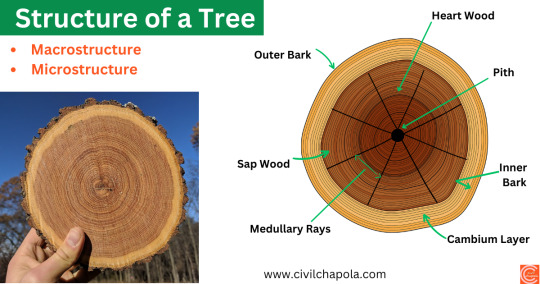
View On WordPress
#branches#building materials.#cambium layer#environment#function#heartwood#inner bark#leaves#macrostructure#medullary rays#microstructure#outer bark#pith#roots#sapwood#structure#structure of tree#timber#tree#trunk
1 note
·
View note
Text

Saw a company car that had this logo
Whoever decided to name the company XYLEM with the motto LET'S SOLVE WATER👏👏👏👏👏
as someone who likes working with plants for some plants they have tubes along their stems n stuff the xylem brings water, and nutrients, UP and the phloem brings sugars and stuff down.
2 notes
·
View notes
Text
Nature Journaling - Girdled Tree
Originally posted on my work website but I wanted to share it here too.

Whenever I’m leading a hike or even just talking with visitors in the nature center, there are always a few questions I find myself answering frequently enough that they stick in my mind. So, during a chilly hike through the fresh snow a few days ago, I stumbled upon the cause of one of these often asked questions: “Why is there a ring cut into some of the trees throughout the forest?”
To me this is the kind of question that begs for an entry in my nature journal, it’s the perfect subject o spark curiosity, make careful observations, and in this case, follow up with answers. But as much as I enjoy nature journaling outdoors, a growing cold breeze reminded me I could finish the project in the office, so I took some photos, made some notes about what I could see or feel and go to work in the warmth of the Nature Center.
Journaling About an Odd Tree
But my eyes, and fingers, are drawn to the sap, frozen by the temperature, mid-drip down the side of the tree in off-white streaks. In warmer months, I’ve touched it and pulled away sticky fingers, but now, the sap is solid, a little flaky, and cemented to the bark of the tree. I can’t help but think about maple syrup and wonder, how cold does sap need to be to freeze?
So many questions, thoughts, and ideas pop into my mind every time I see these trees. And while I could go on for pages about all three topics, I think I’d like to these observations to answer the question posed earlier: “Why is there a ring cut into some of the trees throughout the forest?”
What Makes This Tree Different?
To start, let’s take a moment to identify the tree itself. The trees on our trail system that are subject to this odd process are Norway Spruces, they make up a large portion of the forest just beyond the parking lot and along the trail to our bridges. These evergreens can grow quickly, reaching a height of 60 feet tall in a short twenty years. In its native European habitat, it can even grow to be 150 feet tall!
These trees being so far from their native habitat is part of the reason you might find a cut ring on the trunk. Nonnative trees like this are great for creating quick forests where there was once only agricultural field, but ideally, we want to restore the forest to native species like White pine, Hemlock, Black spruce, and other species. So as new native trees get planted, old Norway spruces get chopped down or have ring cut in them.
This process, called girdling, effectively kills the tree by removing the protective bark and the cambium layer. The bark protects the tree from sickness, fires, impacts and more while the cambium layer is responsible for creating new growth of the tree and passing nutrients between the roots and the canopy of the tree.
Without the protective bark or the cambium pathways for nutrients to travel, the tree will starve. The sap dripping down the trunk can no longer make it to the canopy high above. But it begs the question, “why not just cut the tree down?

Girdled to Make a Healthier Forest
If we wanted to just remove the trees, cutting them down would be best, but girdling some of the trees and leaving them purposely creates standing dead trees which provide essential forest habitat for a wide variety of species including mammals, birds, insects, and even amphibians. Research done on “Attributes of Standing Dead Trees in Forests” indicates that on average, healthy forests in the United States tend to have 11 standing live trees for every standing dead one. By girdling a few trees, we are purposefully creating habitat that better aligns with other healthy forests.
So, the next time you hike on a managed trail system and find a girdled tree, pause a moment and try to identify the cambium layer, the state of the sap and what animals might decide to make a home in it. These trees may look odd, but they have an important role to play in our forest habitats.
41 notes
·
View notes
Text
Mod 3: Gymnosperms
Pinus Needle T.S.
It is circular in outline in P. monophylla, semicircular in P. sylvestris and triangular in P. longifolia, P. roxburghii, etc.
Outermost layer is epidermis, which consists of thick-walled cells. It is covered by a very strong cuticle.
Many sunken stomata are present on the epidermis.
Each stomata opens internally into a substomatal cavity and externally into a respiratory cavity or vestibule.
Below the epidermis are present a few layers of thick-walled sclerenchymatous hypodermis. It is well developed at ridges
In between the hypodermis and endodermis is present the mesophyll tissue.
Cells of the mesophyll are polygonal and filled with chloroplasts. Many peg-like infoldings of cellulose also arise from the inner side of the wall of mesophyll cells.
Few resin canals are present in the mesophyll, adjoining the hypodermis. Their number is variable but generally they are two in number.
Endodermis is single-layered with barrel-shaped cells and clear casparian strips.
Pericycle is multilayered and consists of mainly parenchymatous cells and some sclerenchymatous cells forming T-shaped girder, which separates two vascular bundles. Transfusion tissue consists of tracheidial cells.
Two conjoint and collateral vascular bundles are present in the center. These are closed but cambium may also be present in the sections passing through the base of the needle.
Xylem lies towards the angular side and the phloem towards the convex side of the needle.
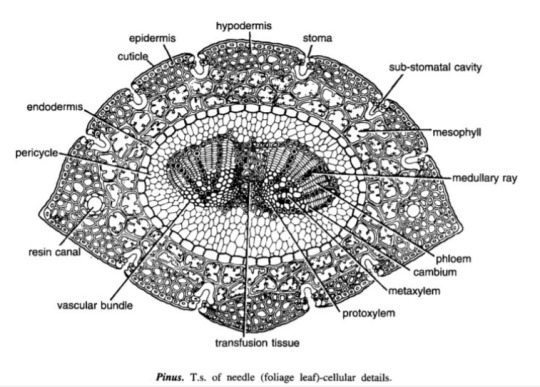
Idk where to find xeric nature info
Williamsoniaceae
Occurrence of Williamsonia
Williamsonia belongs to family Williamsoniaceae of Bennettiales.
It has been reported from Upper Triassic period but was more abundant in Jurassic.
This was earlier discovered under the name Zamia gigas by Willamson in 1870 but has now been named as Williamsonia.
Professor Birbal Sanhi (1932) described W. sewardiana from Rajmahal Hills of Bihar (India).
External Features of Williamsonia
Williamsonia resembled Cycas in appearance, but its best-knows species is W. sewardiana. The plant had an upright, branched, and stout stem covered by persistent leaf bases.
A terminal crown of pinnately compound leaves was present. For the stem genus Bucklandia, Sharma (1991) opined that features of leaf bases such as their shape, size and arrangement pattern are of taxonomic significance.
He observed that leaves in Williamsoniaceae show syndetocheilic stomata with rachis possessing collateral endarch vascular bundles.

Reproduction in Williamsonia
The fructifications of Williamsonia were large and attained a diameter of about 12 cm.
They were borne on a peduncle.
Many spirally arranged bracts were present around the base of the floral axis.
In W. gigas the cones were present among the crown of leaf bases while in W. sewardinia they were present on the short lateral branches.
Williamsonia plants were unisexual.
Female Flower
The female 'cones' of W. gigas and W. sewardiana have been investigated in detail. Instead of 'strobili' or 'cones', Sporne (1965) proposed to use the term 'flower'.
The conical receptacle was surrounded by many perianth-like bracts. The ovules were stalked.
The apex of the receptacle was naked and sterile. The nucellus was surrounded by a single vascularize integument, which was fused with the nucellus. The nucellus had a well-marked beak and a pollen chamber. In young ovules the micropylar canal was long and narrow.
In mature ovules, the canal widened because of the formation of nucellar plug and disappearance of interlocking cells. In the apical part of the endosperm, Sharma (1979) observed 2 or more archegonia.

Male Flower
Male flowers consisted of a whorl of microsporophyll's which were united to form a more or less cuplike structure. In majority of the investigates species the sporophylls were un-branched but in some species they were also pinnately branched.
Sitholey and Bose discovered W. santalensis from Upper Gondwana, and observed that microsporophyll's in the species were bifid.
One of the branches of microsporophyll was fertile while the other was sterile. The fertile part has finger-like structures called synangia. Each synangium had two rows of chambers enclosing microsporangia.
The fertile branch of the bifid sporophyll possessed many purse-like capsules, in each of which there were present many monocolpate pollen grains.

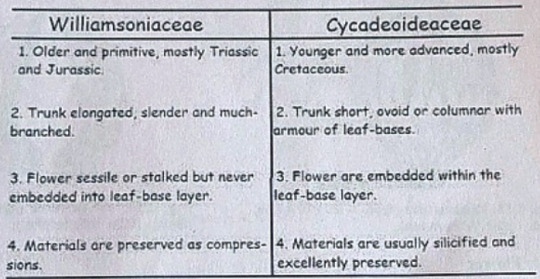
Cycadeoideaceae
Classification:
Division - Cycadeoidophyta
Order - Cycadeoideales
Family - Cycadeoideaceae
Genus - Cycadeoidea
Introduction:
Cycadeoidea is the only genus of family Cycadeoidaceae, represented by thirty species. They are entirely extinct and resemble cycads in the outward stumpy appearance of trunk and an apical crown of pinnate compound leaves. This fossil group of plants flourished during the Triassic to Cretaceous periods of the Mesozoic era. They are reported from various places in the world, in India the Cycadeoidales are found in Rajmahal Hills in Bihar. The petrified trunks of C. entrusca are the oldest fossil ever collected by man.
External Features:
The genus Cycadeoidea had a short, branched, or unbranched spherical, conical, or irregular trunk. The diameter of the trunk is 50cm and the highest rarely reached a meter except in C. jenneyana, it attended the height of several meters. These trunks are covered by rhomboidal leaf bases having multicellular hairs in between. Crown of 10ft long pinnate compound leaves are present at the top.
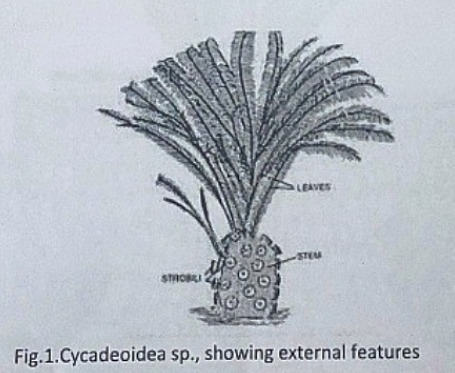
Anatomy of Stem:
The transverse section of the stem shows roughly a circular outline. The epidermis is not very distinct due to the presence of heavy armor of leaf bases. The cortex is parenchymatous and traversed by mucilage canals and numerous leaf traces. The primary vascular structure consists of a ring of endarch, collateral, conjoint, and open vascular bundles encircling the pith. Pith is wide and parenchymatous. A ray-like extension passes between the vascular bundles that make their appearance discrete.
There is a cambium ring with a thin zone of secondary wood. The secondary wood encircles the primary xylem and consists of tracheids with scalariform and bordered pits. The secondary medullary rays traverse the secondary xylem and secondary phloem.
The C-shaped leaf traces arise singly from the primary vascular strand and entering the cortex divided into several masarch strands and enters straight into the leaf.
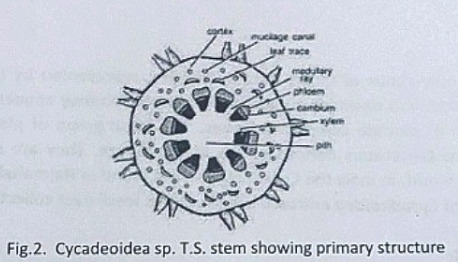
Anatomy of Leaf:
The pinnules show xerophilous structure. The upper and lower epidermis is heavily cutinized and thick walled. The mesophyll cells are distinguished into palisade and spongy parenchyma. The vascular bundles are mesarch and surrounded by bundle sheath.
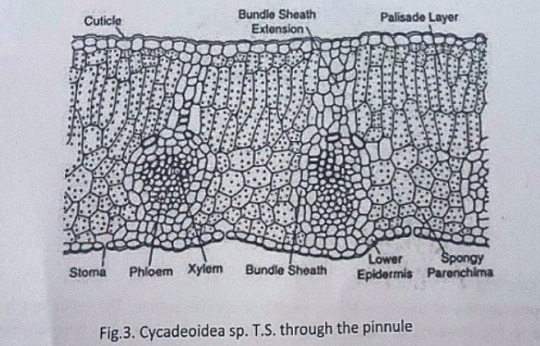
Reproduction:
The reproductive structure is represented by flowers. In most of the species, the flowers are bisexual and arise in the axil of each leaf.
Structure of Flower:
The flowers are bisporangiate, stalked, and partially sunken in the leaf base armor. Rach such mature flower is 5-10cm in diameter and 10cm long. From the base of such flowers about 100 to 150 hairy bracts arise in close spiral little below the apex. These bracts formed a perianth like structure and protect the megasporangiate and microsporangiate parts of a flower. The microsporophyll or androecium forms a whorl united at the base into a sheath. The megasporophyll or gynaecium consists of numerous stalked ovules born around a central receptacle. Between the ovules, interseminal scales with expanded tips are present. These expanded tips fused to form a continuous surface with pores, through which the micropyle of ovules extended. The vascular supply of flowers consists of many branches from leaf traces.
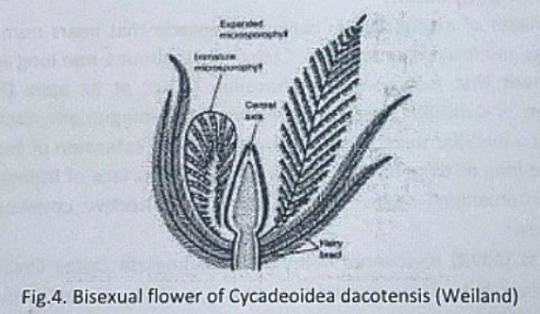
Microsporophyll or Androecium:
The microsporophyll is 10-12cm long, consists of a central rachis bearing numerous pinnae. The pinnae bear two rows of bean-shaped shortly stalked pollen capsules or synangia. These pollen capsules are born on the trabeculae within the fertile region of microsporophyll. A line of dehiscence is also visible at the base of each microsporophyll. This suggest that the entire microsporophyll might have been shed as a unit. The pollen capsule or synangia measures about 3.5x2.5mm and its wall is several layers thick, the outer layer made up of palisade like cells, and the inner layer is made up of thin-walled cells followed by a tapetum. The tapetum was not demarcated. A ring of microsporangia arranged around the periphery of each synangium. The microsporangia dehisce longitudinally and release the microspores into the synangial cavity. At maturity, the synangia liberate these microspores outside by an apical opening that splits into two valves. The liberated microspores or pollens are oval, measures up to 68µ that represents the male gametophytes. Pollen grains of Cycadeoidea are multicellular.
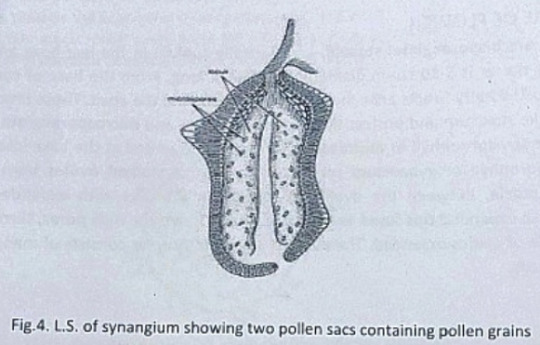
Megasporophyll or Gynoecium
The gynoecium consists of a spherical or conical receptacle that bears numerous stalked orthotropous ovules and interseminal scales. Each ovule is about 1mm long and consists of the single integument that fused with the nucellus except at its apex.
According to Lignier, in C. morieri, nucellus is free from the integument. Each ovule has a pollen chamber and a nucellar beak. This nucellar beak is the extension of the integument. The ovules also have long micropyle, extended from the flat surface of interseminal scales. The fused tips of interseminal scales form an external protective covering or pericarp surrounding the seeds.
Crepet and Delevoryas discovered many of bisporangiate cones from the Cretaceous of black hills. They studied the structure of these ovules in detail. These ovules are urn-shaped and resemble with the ovules of C. wellsii. According to them the micropyle of these ovules are funnel-shaped due to the constriction below the flaring. The inner wall of the micropyle is lined with large cells, considered to be epidermal cells. The integument has three distinct layers. The outer fleshy layer of radially elongated cells, the middle stony layer made up of thick-walled cells, and the inner layer is fleshy.
The young nucellus is made up of thin-walled cells. The cells at the micropylar end are much elongated (80µ long) in comparison to the cells of the chalazal end. The cell at the nucellar tip is pointed up tp whereas cells on either side are bend outward to give the nucellus a distinct shape.
Crepet and Delevoryas reported a linear tetrad or row of three cells in the center of the nucellus.
The seeds are somewhat elongated or oval and possessed two cotyledons.

#exam season#send help#biology#notes#science#botany#gymnosperms#pines#pine trees#pine needles#plants#plant science#plant biology#nature#long post
8 notes
·
View notes
Text
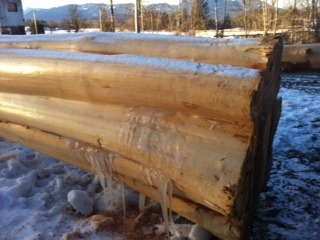

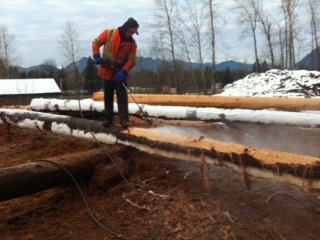
It's #TimberTuesday! Today's topic is latewood finish!
What is latewood? Latewood refers to the winter growth of the tree where by using high pressure water we remove the bark and inner cambium layer exposing and preserving the inherent surface which is full of character and unique contour that most would never have believed existed.
The result of harvesting a Western Red cedar log in the winter months is a naturally shiny, soft to the touch log, to build a stunning log home.
#latewood#latewoodloghome#logsmith#handcraftedlatewood#loghomebuilders#natural#handcraftedloghome#cambium#westernredcedar#craftsman#handcrafted#educationalpost
4 notes
·
View notes
Text
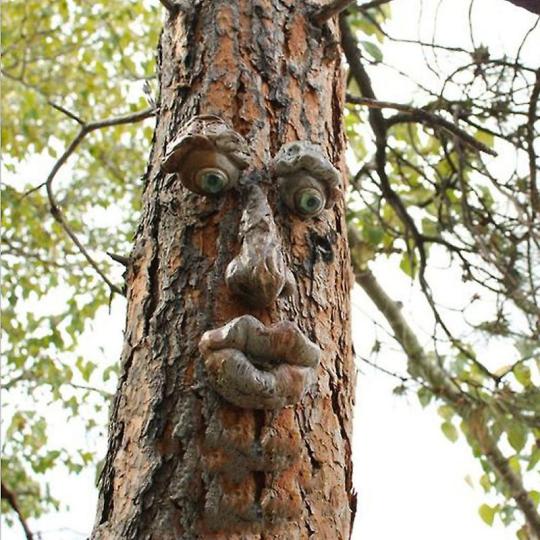
All about Tree Bark how does this help your Animal.
So why tree bark? It is well known that the power of antioxidants improves health, pine bark extract like pine oil is one of nature’s super antioxidants. It is the pine bark extract is a powerful ingredient because the super antioxidant is loaded with oligomeric, proanthocyanidin compounds in short known as opcs. Tree bark is a short way beneath the outer surface of a tree’s trunk and branches, there is a layer called the cambium. With each growing season the cambium adds a new layer of cells to the xylem which it surrounds and protects the tree.
The same ingredient can be found in grape seeds, the skin of peanuts and witch hazel bark opcs is known for their antioxidant producing benefits, these amazing compounds exude antibacterial, antiviral, anticarcinogenic, anti- aging, anti-inflammatory and anti-allergic properties.
So, what are some of the benefits? Reduce muscle soreness improve poor circulation, high blood pressure, osteoarthritis, diabetes, skin, eye disease, help with natural ear infection, stimulates bile flow, acts as a gentle laxative, promotes effective digestion of fats, corrects excessive discharge of mucus into the gastro intestinal tract, helps with jaundice, pancreatic disease, improves liver enlargement, helps with nausea, relieves constipation, diabetes, improves appetite, acts as diuretic and benefits kidneys, reduces mild fevers.
This can also be used in conjunction with other medication use proven products that are designed for animals.
7 notes
·
View notes
Quote
new growth in trees comes from the outer-most layer, living cambium. most of what is dead cannot be seen except in the way it echoes through the wood. the events past, long lost to memory, still haunting the body. i don’t think we can fully imagine what we are attempting to grow from as much as what we are trying to grow into
Robert Américo Esnard, “Dendrochronology of a Family Tree”
7 notes
·
View notes
Text

I’ve been on a bit of an unofficial hiatus due to a family death, but I can’t let World Wildlife Day slip by without sharing one of my favorite animals with you all: the Prehensile-Tailed Porcupine! I fell in love with these guys several years ago after Hank Green highlighted one named Kemosabe on his show and it made baby noises while eating fruit! Here are some facts about them:
* They are small mammals
* They use their prehensile tail to grasp things, and half of the weight of the tail is because of muscle
* They live in the South American forests of Venezuela, Guiana, Brazil, Bolivia, Paraguay, Trinidad, and some extreme northern sections of Argentina
* They are also excellent climbers and spend the majority of their time in trees
* They are herbivores that eat leaves, flowers, shoots, roots, and the cambium layer beneath some trees’ bark
* They are nocturnal, typically sleeping during the day in the upper canopy of trees, although they have also been found resting on lower limbs and in hollow trunks and lower burrows. They are reported to move to a new tree each night
* Lifespan: Life expectancy in human care ranges from 12 to 17 years
* For more information, visit the Smithsonian’s National Zoo & Conservation Biology Institute website
#prehensile tailed porcupine#illustration#wildlife art#wildlife artist#maine illustrator#maineartist#procreate#wildlife illustration#digital art#watercolor#digital watercolor#porcupine illustration#porcupine art#world wildlife day
5 notes
·
View notes
Text
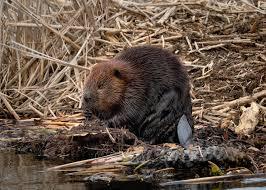
do beavers eat wood
DO BEAVER EAT WOOD?
Beavers do not eat hardwood or the whole tree as most people think. But they eat the inner bark of trees and can eat the softer wood just below the bark. In fact, they eat the cambium layer of the tree by chewing the bark or twigs and then spitting out the wood.
0 notes
Text
#2102 - Tritymba sp. - Ghost Scribbler Moths
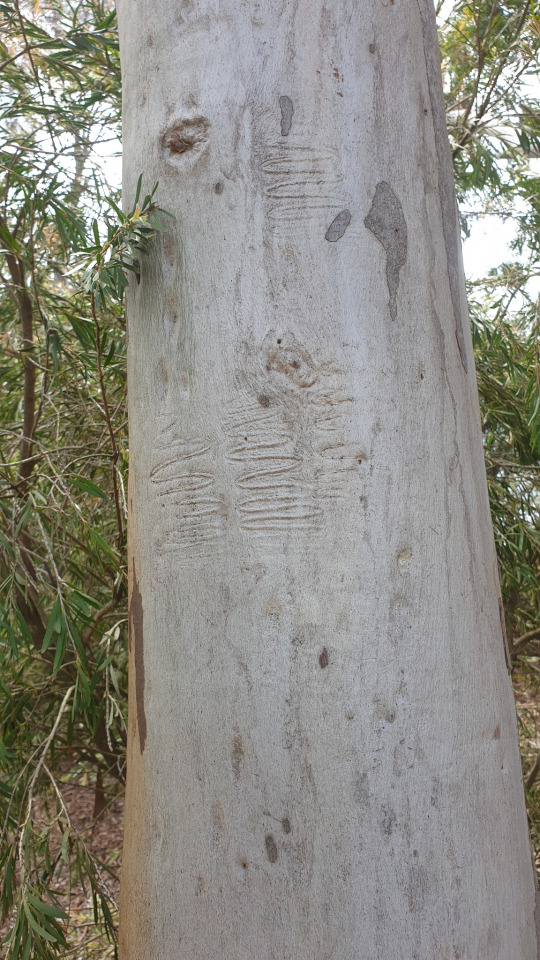
Small Bucculatricid moths that target eucalypts.
The better known Scribbly Gum Moths (Ogmograptis spp.) target smooth-barked eucalypts in the Australian Capital Territory, New South Wales and Queensland, leaving dark zig-zag trails, but the Ghost Scribblers take several more years to be revealed and are much less obvious.
In both cases the caterpillers excavate distinctive winding trails tunnels in the cambium - in the future cork layer between the old and new bark in the case of Ogmograptis, and the deeper vascuar cambium for Tritymba. The initial tunnels are irregular loops, but as the caterpillar grows they become tight zigzags. By the final instar the tree has filled the tunnels with spongey, nutritious scar tissue, and the caterpillars double back to eat that, bore their way to the outside of the trunk, and pupate in the leaf litter. Later, the cork cambium develops into proper cork tissue to flake off the old bark, and the dark scars left by Ogmograptis are revealed, and much later the scars left by Trimtymba show up on the surface. And since Tritymba also target eucalypt species that have rough bark, sometimes the Ghost Scribblers are never revealed at all.
Most other Bucculatricids are tiny leaf miners in the genus Bucculatrix, and the taxomony of Ogmograptis, Tritymba and another Australian genus Cryphioxena has been a bit confused - it's only been a recent paper that closely examined the moths and their DNA that even put them all in the same family, as well as uncovering 10 new species of Ogmogratis.
The Wikipedia page for the Bucculatricids is a bit odd - it appears a lot of the names given there are direct translations of the Latin - hence such intriguing names as 'I Didn't Care About The Mouthpiece', 'Escapee From The Mouthpiece' and 'A Bottle of Absinthe'.
0 notes
Text
Beneath the Bark: Unveiling the Hidden Life of Trees
Have you ever stopped to wonder about the intricate world concealed beneath the bark of a tree? While the exterior of a tree may seem static and unchanging, beneath the surface lies a fascinating and dynamic ecosystem. In this blog, we will delve into the hidden life of trees, exploring the secrets that lie beneath the bark and how they contribute to the vitality of our planet.
The Bark's Protective Armor:
Bark serves as the protective armor for trees, shielding them from external threats such as pests, diseases, and extreme weather conditions. Just like our skin acts as a barrier for our bodies, the bark plays a crucial role in maintaining the health and well-being of trees.
The Cambium Layer:
Underneath the outer bark lies a thin layer called the cambium. This unassuming layer is responsible for the growth of the tree, producing both inner wood and outer bark. As the cambium cells divide and multiply, they give rise to the annual rings that tell the story of a tree's life. Each ring reflects a year of growth, capturing the environmental conditions and challenges the tree faced.
Transportation Highways:
The inner layers of a tree's bark are not only responsible for protection and growth but also serve as transportation highways for essential nutrients. The phloem, a tissue located just beneath the bark, transports sugars produced during photosynthesis from the leaves to other parts of the tree. This intricate network ensures that every part of the tree receives the nourishment it needs to thrive.
The Role of Mycorrhizal Networks:
Beneath the soil, an unseen partnership exists between trees and fungi through mycorrhizal networks. These networks facilitate the exchange of nutrients and information between different trees, creating a community that supports the health of the entire forest. Trees can communicate with each other through chemical signals transmitted by these fungi, warning their neighbors of potential threats such as insect infestations.
Adaptations for Survival:
Beneath the bark, trees have evolved remarkable adaptations for survival. Some species have developed specialized structures to store water, helping them endure periods of drought. Others produce chemicals to deter herbivores or combat diseases. Understanding these adaptations not only reveals the resilience of trees but also highlights their vital role in maintaining ecological balance.
The Impact of Human Activity:
As we unveil the hidden life of trees, it becomes evident that human activity can have profound effects on this intricate ecosystem. Deforestation, pollution, and climate change pose significant threats to the health and survival of trees worldwide. Recognizing the importance of preserving these ecosystems is essential for the well-being of our planet.
In conclusion, the hidden life beneath the bark is a testament to the complexity and resilience of trees. From the protective bark to the intricate networks underground, trees harbor a world of wonders that contribute to the balance of our ecosystems. As stewards of the environment, it is our responsibility to appreciate and protect these silent giants, ensuring that future generations can continue to marvel at the hidden life beneath the bark.
0 notes
Text
Mod 2: Pteridophytes
Internal Structure of Lycopodium
Root:
A T.S. of root shows 3 distinct regions:
Epidermis: Single layered made up of thin walled cells.
Presence of unicellular root hairs.
Root hairs in lycopodium arise in pairs.
Cortex: Composed of parenchymatous cells.
On older roots, the outer layer of cells of cortex became thick walled and provide support.
Stele: The central part of the root is occupied by a protostele which is monarch in young roots but became diarch or triarch in older roots.
The xylem is C-shaped and phloem lies in between the arms of the xylem.
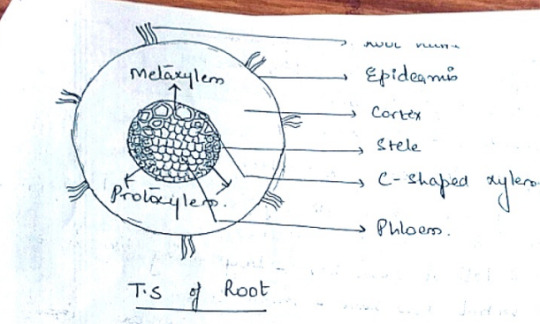
Stem:
Stem is also differentiated into epidermis, cortex, and stele.
Epidermis: Forms the outermost protective layer. The outer walls are thick and cutinized.
Stomata present in epidermis of young stem.
Cortex: The structure of cortex varies depending on the species and stem diameter.
It is homogenous - remains parenchymatous through out.
Shows distinct tissue zonation - chlorenchymatous hypoderm, sclenchymatous around the stele, and parenchymatous between above 2 zones.
The innermost layer of cortex forms endodermis followed by 2-6 layered pericycle composed of thin walled cells.
Stele: All the species of lycopodium have protostele but they differ in the arrangement of xylem, phloem, and the parenchyma cells:
a) Plectostele: Xylem and Phloem occur in parallel rows separated by parenchyma.
b) Actinostele: Presence of star shaped xylem and phloem in between the arms of xylem.
c) Mixed Protostele: In few species, xylem and phloem cells are uniformly intermixed.
The xylem is differentiated into protoxylem and metaxylem elements exarch condition.
There is no cambium between xylem and phloem and hence no secondary growth.

Leaves:
The leaf is triangular in outline.
Epidermis is covered with thick cuticle.
Most of the species are amphistomatic, i.e. stomata are distributed uniformly on both the surfaces.
Few species are hypostomatic, where stomata are confined to the lower surface.
The mesophyll is undifferentiated and consists of chlorophyllous cells with large intercellular spaces.
The leaf has median concentric vascular bundle with central xylem surrounded by phloem.
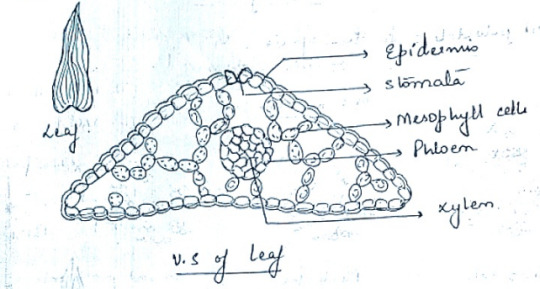
Internal Structure of Equisetum
Aerial Shoot:
The anatomy of the stem shows a combination of hydrophytic and xerophytic characters. The nodes and internodes have different internal structures.
a) Internode: A T.S. of internode is wavy in outline due to the presence of ridges and grooves. It has epidermis, cortex, stele, and central pith.
Epidermis: Composed of single layers of cells with heavy deposition of silica (on both outer walls and also the radial walls).
Epidermis is interrupted by stomata that are usually confined to the grooves.
Stomatal apparatus is composed of (fom??) cells arranged in 2 tiers of 2 cells each.
Cells in lower tier = Guard cells
Cells in upper tier - Subsidiary cells
These stomata are generally sunken but in one species they are at the level of the epidermis.
Cortex: Differentiated into an outer and an inner region.
Outer cortex has several layers of sclerenchymatous cells which provide mechanical strength and a layer of chlorenchymatous cells which provide photosynthetic regions of shoot.
Inner cortex has parenchymatous cells. It has large canals known as vallecular canals, below the furrows. These canals extend throughout the length of the internode and form an aerating system.
Endodermis: Cortex is delimited from the stele by an endodermis which varies in position:
i) E. palustre has a single layer of endodermis outside the stele.
ii) E. debile has two endodermal layers, an outside stele and one on inner side of the stele.
iii) E. giganteum has layers around each vascular bundle.
Pericycle: Endodermis is followed by a single layered pericycle of parenchymatous cells.
Stele: The vascular cylinder is a siphonostele, where vascular bundles are arranged in a ring around the large pith.
The vascular bundles lie in position alternate to the vallecular canals and lie opposite to ridges.
The bundles are conjoint, collateral, and endarch.
In a mature vascular bundle the protoxylem elements disintegrate to form a conspicuous protoxylem lacuna called carinal canal. Some of the protoxylem elements, however, can be seen along the periphery of the carinal canal. Metaxylem tracheids have scalariform, reticulate, and pitted thickenings.
Phloem lies outside the xylem and in radial alignment with carinal canal. Made up of sieve tubes and phloem parenchyma.
Carinal canals are filled with water and help in the conduction of water whereas vallecular canals have only air.
Pith: The central region is occupied by a large pith cavity.
In some species, pith is absent.
The internode shows the following:
Xerophytic features:
1. Presence of ridges and grooves.
2. Outer and radial walls are impregnated with silica.
3. Presence of sunken stomata.
4. Presence of well developed sclerenchymatous hypodermis.
5. Presence of well developed vascular cylinder.
Hydrophytic features:
1. Presence of well developed aerating system, i.e., vallecular canals and central pith cavity.
2. Presence of reduced xylem, represented by few protoxylem and metaxylem tracheids only.

b) Node: The internal structure of the node differs from the internode in the following features:
1. Pith is not follow in the mode and instead a nodal diaphragm is present.
2.Vallercular canals are usually not present.
3. Vascular bundles fuse together and form a vascular cylinder around the nodal diaphragm.
4. Carinal canals are absent.
5. Leaf and branch traces arise from the vascular cylinder of the node.

Rhizome
The internal structure of the rhizome differs from the aerial shoot in the following features:
1. Epidermis without stomata.
2. Outer cortex is less sclerenchymatous.
3. Cortex without chlorophyllous cells.
4. The vallecular and carinal canals are marrow in comparison to those in aerial shoot.
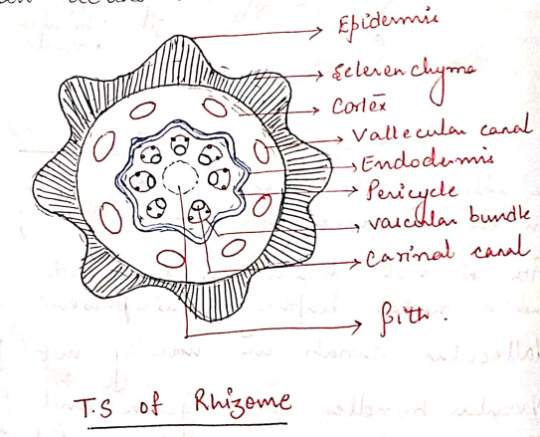
Root
Transverse section of the root shows epiblema, cortex, and stele.
Epiblema: The single layered epiblema forms the outermost protective covering of the root. Some sells elongate to form root hairs.
Cortex: Epiblema is followed by a wide cortex.
Outer cortex is sclerenchymatous (exodermis) while inner cortex is parenchymatous (has intercellular spaces)
Endodermis: A characteristic feature of the root of equisetum is the presence of a 2 layered endodermis.
In outer endodermis the cells are larger with casparian bands while in inner endodermis the cells are smaller without casparian bands.
Pericycle is absent and lateral roots arise from inner endodermis.
Stele: A protostele is present in the center of the root with diarch to tetrarch xylem. The number of xylem strands usually increases with the diameter of the root.
A large metaxylem tracheid is present in the center of the stele and the protoxylem strands lie around it. The phloem is present in between the protoxylem strands.
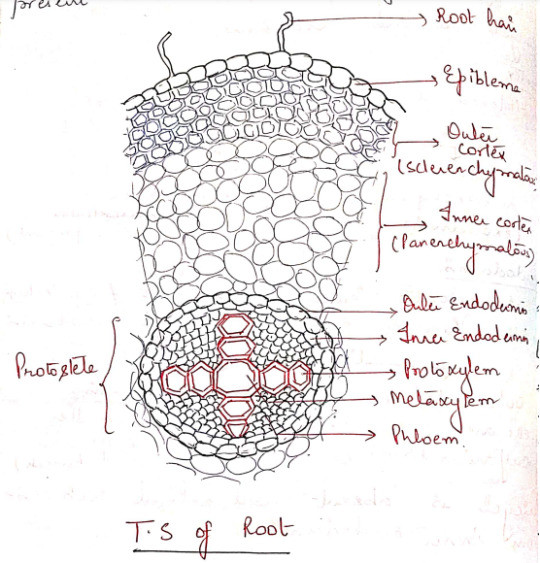
Internal Structure of Marsilea
Rhizome
The transverse section of the mature rhizome shows the following structures:
Epidermis: Single layer of compactly arranged thick walled cells. It does not have stomata.
Cortex: Made up of three layers:
Outer cortex is composed of parenchymatous cells with air chambers called arenchyma. Air chambers are separated from each other by single layered septum - Trabeculae.
Middle cortex is made up of sclerenchyma cells.
Inner cortex is made up of parenchyma cells.
Stele: The vascular cylinder is an amphiphloic siphonostele. Xylem is surrounded both externally and internally by phloem, called outer phloem and inner phloem respectively.
The outer endodermis and pericycle surround the stele externally and the inner endodermis and pericycle internally. All these layers are single layered.
The central part of the stele is occupied by a sclerenchymatous pith.
In xerophytic species, pith is sclnotic(??) and air chambers are not present in the outer cortex.

Petiole:
The petiole is also differentiated into:
Epidermis: Single layer of compactly arranged rectangular cells.
Cortex: Differentiated into outer arenchymatous cortex and inner parenchymatous cortex.
The inner cortex contains starch grains and few cells contain tannins.
Stele: Surrounded by a layer each of endodermis and pericycle. Endodermal cells are characterized by the presence of companion(??) bonds.
The xylem consists of 2 strands, each forming a curved arch. The 2 arches are closer to each other in the middle but then outward on either side.
The metaxylem is present towards the base of the arch while the protoxylem towards the apex.
The xylem is surrounded by phloem. Pith is absent. Haplostele(why is this word here)
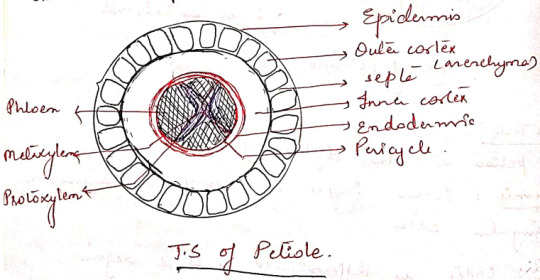
Leaf/Leaflet
The section of the leaflet shows mesophyll tissue sandwiched between two epidermal layers. Both the upper and lower epidermis are single layered and covered by cuticle.
Epidermis is interrupted by stomata.
Aquatic floating species: stomata is confined to upper epidermis.
Terrestrial species: stomata present on both layers.
Mesophyll is differentiated into 2:
Palisade parenchyma: made of compactly arranged cells in 2 layers below epidermis.
Spongy parenchyma: cells are loosely arranged with intercellular spaces.
Mesophyll is not differentiated in submerged aquatic species.
The vascular bundles are concentric, with a central xylem surrounded by phloem. Each vascular bundle is surrounded by a layer of endodermis.
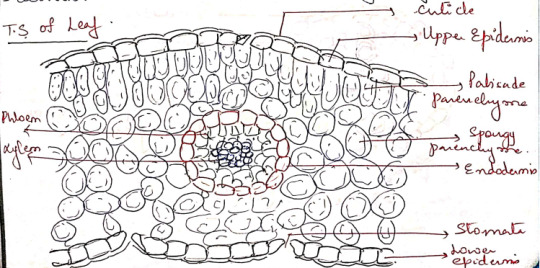
Root
The transverse section of root shows 3 distinct regions:
Epidermis: Composed of single layered cells that are compactly arranged.
Cortex: Differentiated into 3 layers:
Outer cortex is arenchymatous. Air chambers arranged in a single row.
Middle cortex is of thin walled parenchymatous cells.
Inner cortex is made of sclerotic cells.
Stele: The stele is surrounded by a later each of endodoermis and pericycle.
The xylem is diarch and exarch. It has metaxylem element in the center and protoxylem elements towards the periphery.
The phloem is present on either side of xylem.
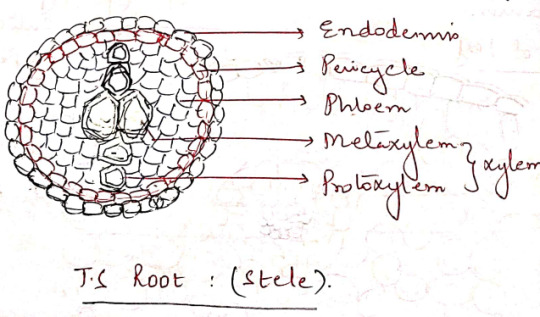
Rhynia
Classification
Class - Psilopsida
Order - Rhyniales
Family - Rhyniaceae
Genus - Rhynia
Occurrence
The name of the genus Rhynia is derived from the place "Rhynie' in Scotland.
Rhynia is a fossil obtained from peat deposits.
Rhynia was a primitive vascular plant that grew in swampy marshes. Because of volcanic eruption, rhynia became a petrified fossil. (embedded and impregnated with silica)
Species of Rhynia: R. major.
Sporophyte/External Morphology
The plant of Rhynia was a sporophyte. It grew up to a height of 20cm.
The plant body is differentiated into 3 regions: a horizontal rhizome, leafless aerial shoots arising from the rhizome, and rhizoids.
The leafless aerial shoots are dichotomously forked. Elongated sporangia were present at the tips of few branches.
Rhizoids are present on the underside of the rhizome in patches.
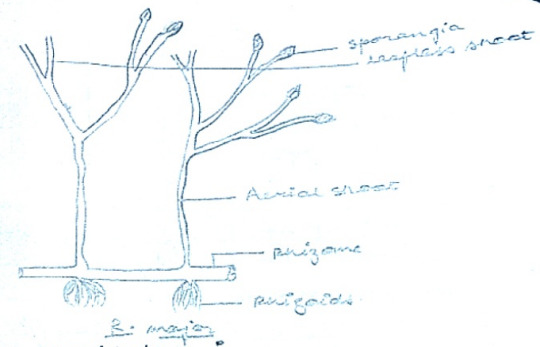
Internal Morphology
The internal structure of rhizome and aerial shoot was similar.
It was differentiated into:
Epidermis: Single layered cells. The aerial stem epidermis is covered with cuticle and shows stomata; rhizome has no stomata.
Cortex: further differentiated into outer and inner cortex:
Outer cortex: aka hypodermis, 1-3 layered parenchymatous cells without intercellular spaces.
Inner cortex: parenchymatous cells with intercellular spaces. The chief photosynthetic tissue of the plant.
Stele: Protostele, cylindrical mass of xylem surrounded by phloem.
*insert diagram, it's literally just a xylem circle inside a larger phloem circle*
Reproductive Structures
The sporangia were borne at the tip of the aerial shoots.
They are simpler in structure.
It was cylindrical in shape with broad base and slightly narrow apex.
The sporangium has a jacket (several cells in thickness). It is covered with cuticle. There was no columella in the center.
The sporangial cavity contained many spores (homosporous).
There is no specific dehiscence mechanism and the spores are released only after the decay of the jacket layer.
The innermost layer of jacket acts as Tapetum.
The gametophyte of Rhynia is not known.

Phylogenetic Significance of Rhynia
Rhynia and other members of Rhyniaceae represent the most simple and oldest vascular plants.
The organization of the plant body is algae like, but due to the presence of vascular system, it is not included in thallophytes.
If the sporangia and the aerial shoots were the only known portion of the plant body, one would assign it to bryophytes.
Zimmermann, in his telome theory, holds that the primitive shoot was upright, dichotomously branched, leafless, and similar to that of Rhynia.
He called the ultimate dichotomies as the "telomes."
The structural attributes of Rhynia like photosynthesis performing shoot, thick cuticle, developed stele, and presence of stomata clearly indicate that this plant cannot be considered the first land plant.
Some believe that the plants of Rhyniaceae became reduced due to unfavorable environmental conditions.
Telome Theory
Telome theory was first proposed by Zimmermann in 1930. According to his theory, vascular plants have evolved from a simple, leafless, rootless, and dichotomously branched sterile and fertile axes called telomes. which originated from radially symmetrical and dichotomously branched algal ancestors.
The other plants developed leaves, roots, sporangia, and other organs by modification and differentiation in telomes.
Zimmermann termed the extreme terminal portions of plants, having single nerves, as telomes and the internodes below it as mesomes. The telome may be fertile, having single terminal sporangium or sterile without sporangia.
According to this theory, various organs like leaves, roots, sporangia, etc. have evolved from the simplest and earliest vascular plants by 'progressive differentiations' called Elementary processes. They are:
1. Overtopping: During this process, the 2 sister branches of a dichotomy or telome truss become unequal.
One of them grew stronger and became erect, while the other became weaker and pushed aside.
The stronger branch -> became axis
The weaker branch -> became lateral appendage or leaf.

2. Planation: During the process the axis divided dichotomously in more than one planes. These branches were arranged in single plane and have rise to leaves.

3. Syngenesis/Webbing: During this process the telomes and mesomes become fused by the formation of parenchymatous webbing between them. This resulted in the formation of:
i) leaves with dichotomous venation
ii) leaves with pinnate venation
iii) leaves with reticulate venation
iv) shoot with various stele types

4. Reduction: Simplification and reduction of telome truss resulted in the formation of microphylls and needle shaped leaves.

5. Incurvation: During this process, the fertile telomes were reflexed so that the sporangia became inverted in position.
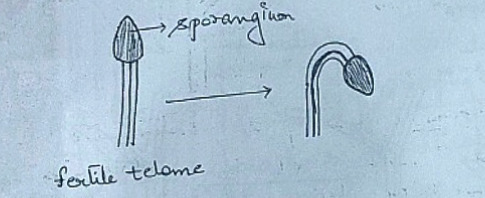
Origin of Leaves
According to Zimmermann's theory, the microphyllous leaves (as in lycopodium) originated by the process of reduction and the megaphyllous leaves (as in marsilea) originated by combined processes of overtopping, planation, and syngenesis.
Origin of Sporophylls: Zimmerman gave 3 different lines of evolution in three main divisions of pteridophytes:
Origin of Sporophylls in Lycopodium:
The sporangia in the members of lycophyta are usually born in the axils of the microphyllus sporophylls.
It resulted in aggregation of fertile and sterile telomes, followed by reduction in the mesomes and the number of sporangia.
It resulted in the formation of single sporangium in the axil of single sporophyll.

Origin of Sproangiophores in Equisetum:
The members of this division are characterized by having sporangia borne on peltate sporangiophores.
The sporangiophores originated by the combined process of
i) Overtopping and reduction in the fertile segments resulting in whorled arrangement.
ii) Reduction of fertile branches leading to the downward bending of the sporangia.
Syngenesis of telomes and mesomes heading to the formation of peltate sporangiophores.

Origin of Sporophylls in Marsilea:
Megaphyllous sporophylls of marsilea were evolved by the combined processes of overtopping, syngenesis, reduction, and incurvation
Overtopping resulted in the formation of pinnate sporophylls.
Syngenesis of mesomes resulted in formation of the marginal sporangia.
Incurvation resulted in shifting of marginal sporangia to the lower surface of the sporophylls.
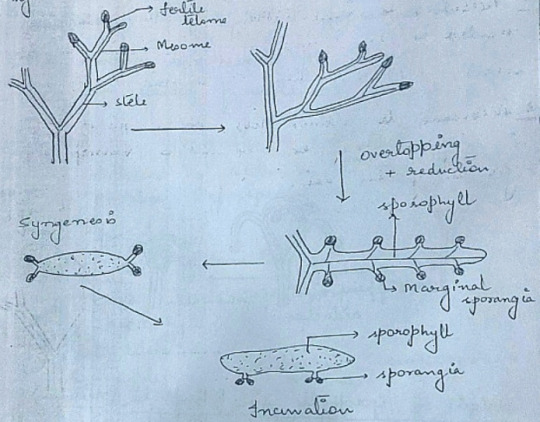
Merits of Telome Theory
Clearly explains the origin and evolution of sporophytes of vascular plants.
This theory is based mainly on the comparative study of fossil as well as living genera of vascular plants.
Most of the assumptions are based on the phylogenetic relationships between various groups of plants.
The elementary processes clearly explain the the manner of evolution of vascular plants.
Demerits of Telome Theory
According to Bower in 1946, the theory took for granted the telome as a fundamental unit without explaining the characteristic development.
According to Eames in 1936, the origin of leaves in lycopodium can be regarded as simple out-growth of the axis.
#exam season#send help#biology#notes#science#botany#plants#pteridophyte#plant science#paleobotany#paleontology#fossils
1 note
·
View note
Text
How Deer Repellent Keeps Your Property Safe
We all love reindeer, but when local deer begin destroying property, some deer repellent action may need to be taken. The deer population in Pennsylvania is estimated to be around 1.5 million. You have probably seen deer around your neighborhood, especially if you live in a rural or suburban area. And as much as we enjoy seeing deer in nature, the damage to your lawn and property by those same deer can be costly.
Late fall and winter is the time period that we focus on deer suppression to protect valuable plants and trees from deer damage. Burkholder PHC will outline a few ways deer can damage your yard and how particular repellent methods can help keep deer out of your garden beds and landscape.

How Do Deer Destroy Lawns?
Deer damage lawns in two primary ways: feeding and antler-rub. These methods damage properties in different ways and may require other solutions to resolve.
Deer Feeding
Feeding is one of the more common ways deer can damage properties, and homeowners should utilize deer repellent. Deer can and will eat various plants and trees in one’s yard: grass, flowers, fruits, vegetables, and leaves; deer will even eat twigs and bark. While deer eating your plants is an obvious problem, a byproduct of their feeding is another type of damage called “browsing.” Browsing is the damage that deer cause by tearing, stomping, and compacting soil when scavenging for food.
Antler-Rub
During winter, male deer rub their antlers on trees to scrape off the velvet-like cover on their antlers to make way for a new cover in spring. The result of antler-rub is vertical scrapes and shredded bark on trees. This damage exposes the cambium, the layer that resides between the inner and outer bark. Cambium helps nutrients move throughout trees, and having this layer exposed to weather, pests, and diseases can harm your trees.
How Deer Repellent Programs Can Help
To make sure that your property is safe from feeding, browsing, and antler-rub damage, some level of deer repellent may be necessary. Below are some methods we can use to prevent deer from intruding on and damaging your property.
To protect plants from deer feeding, agents that change their taste/texture profile can condition deer to stop eating and avoid your plants entirely. Deer have heightened senses of smell and taste, so these deer repellent sprays/agents use smells and tastes that deer generally avoid.
For browsing, physical barriers can prevent deer from entering certain areas of a property, like a flower bed or the boundaries of the property itself.
Metal or plastic trunk sleeves or wraps around trees can help stop antler-rub, especially young or newly planted trees, along with special soaps and odor deterrents to push deer to other unprotected trees.
Each of these measures also changes depending on the season. For example, the tactics for deterring deer in fall and winter may differ from spring and summer, when controlling deer behavior can be more manageable.
Burkholder PHC has a specialty program to help property owners protect their landscapes. If you are interested in our program, reach out to us today.
Contact Burkholder for Deer Repellent Services
If you need deer repellent and want to keep your property safe from deer, contact Burkholder PHC. We have experience helping homeowners protect their yards from various pests, including deer, insects, and many plant diseases. Our plant health care team is highly qualified and knowledgeable about all aspects of plant health care issues and solutions. We will work with you, inspecting your property to determine the best course of action to keep your plants healthy and beautiful. Contact us today for more information about our services and how we can help you.
Blog is originally published at: https://www.burkholderphc.com/how-deer-repellent-keeps-your-property-safe/
It is republished with the permission from the author.
0 notes
Text
Elevated Tree Service
Are you fed up with continually ducking under low-hanging branches as you walk around your property? Or frustrated by the lack of sunlight that filters through your tree canopy? You’re not alone! These are typical issues encountered by many property owners, and they may be both frustrating and hazardous.

Our team of professional arborists has the knowledge and equipment necessary to provide you with high-quality tree-raising services that are tailored to your unique requirements. We examine each tree on your property to establish the best course of action and give a tailored solution. But why us? Learn below.
Benefits Of Tree Elevating
Tree elevating is the process of snipping off the lowest branch of a tree, allowing it to grow healthier with more clearance. Before getting into details, let us first tell you why you should even consider investing in such services.
Elevating trees has numerous advantages for both residential and business premises. Here are some of the primary advantages of our tree-raising services:
Improved Aesthetics
Elevating a tree can improve the overall aesthetic of your home by removing lower limbs. It can make your trees appear taller and more refined, as well as contribute to a more open and inviting environment.
Increased Sunlight
Removing lower branches can also help increase the quantity of sunshine that reaches your property. This is especially advantageous if you have plants or other vegetation that require a great deal of sunlight to flourish. Increased sunlight may help brighten and make your outdoor spaces more attractive.
Reduced Risk Of Damage
Low-hanging branches pose a threat to your home, especially during storms and strong winds. You can lessen the chance of damage to your property, including your roof, windows, and other structures, by removing these branches.
Improved Tree Health
Elevating your trees can also enhance their health. By eliminating lower branches, you can stimulate healthy growth and limit the likelihood of illness and pest infestation. In addition, by trimming dead or broken branches, you can improve your trees’ general health and look.
Our Approach Toward Trees
At our company, we believe in tailoring our tree-elevating strategies to each individual client. Here are some of the ways in which we distinguish ourselves from other tree service providers:
Customized Approach For Each Tree
We recognize that every tree is unique and deserves a customized strategy. Our team of expert arborists evaluates each tree on your property to establish the best strategy for enhancing the tree canopy. To achieve optimal outcomes, we consider the tree’s species, age, size, health, and general structure.
Experienced Arborists And The Latest Tools And Techniques
Our expert arborists have years of experience in tree care. Moreover, they are equipped with the most advanced tools and methods to deliver efficient and effective tree-elevating services. We utilize specialized equipment such as ropes, chainsaws, and ladders to ensure that the task is completed securely and effectively.
Safety And Efficiency
Safety is our company’s top priority. During the tree elevation, we follow strict safety protocols to protect both our staff and your property. Our team is qualified to handle various tree-elevating scenarios and can perform the work with minimal property disturbance.
How We Can Help With Our Elevated Tree Service
If you’re considering tree elevating or lifting in Nassau County, it’s important to be aware of the regulations and best practices. The Nassau County Tree Protection Code permits the lifting or raising of trees as long as it is done in a way that supports the tree’s health and safety.

This necessitates precise pruning techniques, including making cuts at the appropriate place and angle and avoiding damage to the bark and cambium layer. To protect the safety and health of your trees, the licensed and experienced staff at our tree service adhere to all standards and best practices.
Our tree-elevating service is meant to give a variety of benefits to your property. These include boosting the beauty of your trees, increasing sunshine on your property, lowering the risk of property damage, and enhancing the health of your trees. We take a tailored approach to each tree. Thus, ensuring that the task is completed safely and effectively with the most modern equipment and methods.
In Nassau County, the culture surrounding tree care emphasizes the significance of keeping and preserving trees while guaranteeing public safety and accessibility. At our tree service company, we share this commitment to responsible tree care. Moreover, we endeavor to offer the best level of service and quality at all times.
Our Other Services And Service Areas
We are pleased to offer tree-elevating services to residents of Nassau County, New York. Our service area includes both residential and commercial premises, and we are dedicated to personalizing solutions to your specific requirements.
By the way, we also provide the following services too.
Our Commitment To Customer Satisfaction
Our tree service is dedicated to offering the highest degree of customer satisfaction possible. From the initial consultation to the final cleanup, we pay careful attention to every aspect of our tree-elevating services. Moreover, we take the time to comprehend your unique requirements and deliver individualized solutions that exceed your expectations.
Our objective is to not only meet but surpass the expectations of our consumers. We go above and above to ensure customer satisfaction with our services. We recognize that our success is dependent on the happiness of our consumers. Hence, we are committed to offering the greatest level of service and quality and take great pride in our work.
At our tree service company, we believe in establishing long-term client connections. We recognize that satisfied clients are our finest form of advertising, which is why we constantly strive to surpass their expectations. We are committed to providing clients with tree-raising services that are safe, efficient, and tailored to their specific needs.
How To Take Our Service?
If you are interested in our tree-raising services, do reach out to us. We’ll organize a free consultation with one of our seasoned arborists. Who will visit your site to inspect the trees, discuss your individual needs, and propose a personalized solution for your tree elevated service requirements? Feel Free to Fill Up the Contact Us Form. We will reply to you instantly.
0 notes
Text
DAILY DEVOTIONAL FOR AUGUST 7, 2023
Our Life’s Heartwood
By John Alter (Florida, USA)
READ EPHESIANS 3:14-19
"'Lord, my strength and my fortress, my refuge in time of distress, to you the nations will come from the ends of the earth and say, “Our ancestors possessed nothing but false gods, worthless idols that did them no good.”'
JEREMIAH 16:19 (NIV)
"'The day after a hurricane I ventured into our backyard to check the damage. I found one sizable limb that had snapped off where it had joined the trunk of a 50-foot-high tree. The limb measured 15 inches in diameter, and I was puzzled why such a big limb had fractured.
As I looked at the base of the limb, I saw that the inside, its “heartwood,” had rotted away. It had been held to the trunk of the tree by only the weaker outer bark and cambium portions of the limb. When its core had decayed, the limb was weakened; only the frail outer layers of the limb provided support. In the storm, that hadn’t been enough.
The condition of the tree reminded me how we derive our inner strength from our relationship with God. If the core of our union with God is decayed and unhealthy, then we become weak and will not have the strength and resilience to handle the hard times of our lives. But when we have a healthy bond with God, we can remain strong in times of struggle. Through worship, Bible study, and prayer we keep our spiritual heartwood healthy so that we can endure any storm."' Stay in tune with God and concentrate on what He encourages you to do. Be close to Him and you will be able to handle so many things well. If you allow things to not remain close in contact, then you are weaker in the ability to deal with situations. Hold on to God!
TODAY'S PRAYER
"Strengthening God, help us to maintain a healthy connection with you so that we can endure the challenges that come our way." Amen.
Ephesians 3:14-19
"14 This is why I kneel before the Father. 15 Every ethnic group in heaven or on earth is recognized by him. 16 I ask that he will strengthen you in your inner selves from the riches of his glory through the Spirit. 17 I ask that Christ will live in your hearts through faith. As a result of having strong roots in love, 18 I ask that you’ll have the power to grasp love’s width and length, height and depth, together with all believers. 19 I ask that you’ll know the love of Christ that is beyond knowledge so that you will be filled entirely with the fullness of God." The above blessings will come to you; know Christ's love and find God's complete being within. Be blessed! Joe
0 notes
Text
do beavers eat wood
DO BEAVER EAT WOOD?
Beavers do not eat hardwood or the whole tree as most people think. But they eat the inner bark of trees and can eat the softer wood just below the bark. In fact, they eat the cambium layer of the tree by chewing the bark or twigs and then spitting out the wood.
Since they cannot climb trees, you may see them felling a tree to cut off branches, leaves and bark for food or building materials. They also gnaw trees to file down their ever-growing front teeth. This keeps the teeth healthy and strong and prevents the teeth from growing out of the mouth and making it difficult to eat.
1 note
·
View note